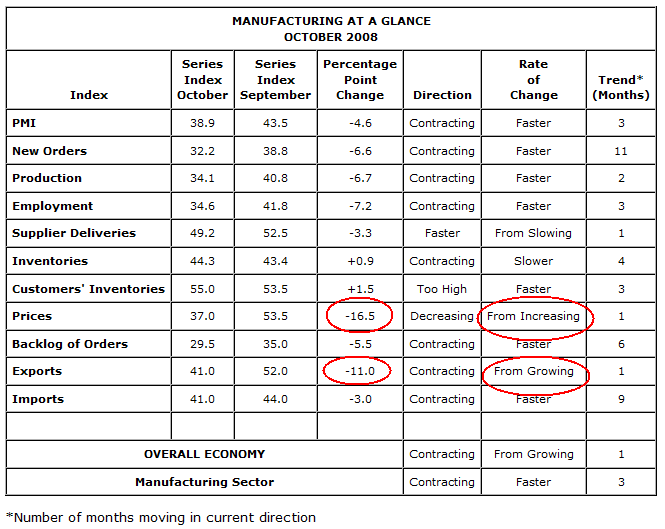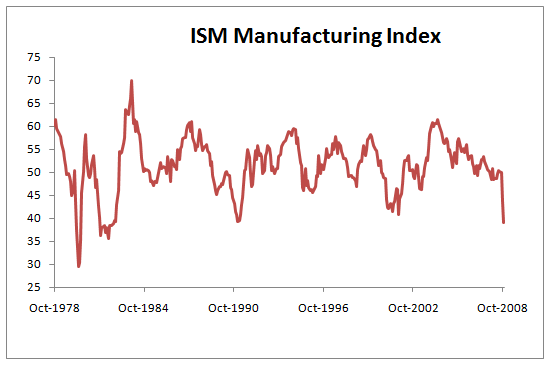ISM Manufacturing Index plummets
If you were not convinced about the severity of the present recession in the United States before, then the ISM Manufacturing index data for October will serve as a wake-up call. The index plunged to the deep recessionary level of 38.9 where 50 is seen as the level separating expansion from recession. Just two months ago, the index was at 50, where it has hovered since September 2007. However, since July the situation for manufacturing in the United States has deteriorated rapidly.
The index now stands at its lowest level in 26 years.
Now, what you will notice from the chart below is the massive move to the downside in prices and in exports. These two data points indicate that the economy has gone from having to worry about inflation to having to worry about deflation. Moreover, the export data means that a stronger dollar and slowing growth abroad is going to have very negative effects on U.S> growth.
Last month, I indicated that production was a key statistic for judging the strength of an economy.
The National Bureau of Economic Research (NBER) is the official arbiter of business cycles in the U.S. If you want to know when a recession occurs, it is the NBER which decides. The NBER relies on understanding four major economic data trends — the economy’s four horsemen:
- How much we spend: retail sales
- How much we earn: real earnings growth
- How much we make: industrial production
- How much we work: employment
When one looks at a composite view of what this data is telling us about the economy, production is signaling severe economic weakness. However, retail sales is signaling a similar plunge as personal consumption expenditures released last week with the GDP data showed consumers are now spending 3 percent less. On the other hand, real earnings growth is mixed, as are the employment data.
The sequence of events generally moves from a reduction in earnings (or, in this case, wealth), followed by a reduction of consumer spending, followed by a cut in production, and only then, followed by a reduction in employment.
What the data suggest is that we are in the beginning stages of a deep recession where much of the effects on employment have yet to be felt. Unfortunately, this means the economy will fall significantly from here.
Update: I forgot to add my chart of the historical numbers.
Source
October 2008 Manufacturing ISM Report On Business® – ISM


Could you please comment on what this means for stock market. Will SP500 test 2002-3 lows ?
I recall you recently mentioned we may have seen the bottom (shortterm?). Is the current trend a short-term bear rally until holidays? thanks!
I think you should take any general market forecasts with a grain of salt unless we are deep into value territory or way into bubble territory — neither of which is true for the market today.
However, take a look at the chart on this post to get a sense of where we are in the stock market cycle.
What this chart is doing is comparing the growth in the economy to the growth in the S&P 500 index. When the S&P is way overvalued, this chart shows positive numbers as it did in 2000 or 2001. When the S&P500 is undervalued, it shows very negative numbers as it did in the late 1970s and early 1980s.
As you can see, this chart suggests that we are in a secular bear market and that this bear market has a considerable period to go. Other criteria like trailing P/E ratios also send the same signals.
What does this mean over the next few months? Nothing, which is why I prefaced the whole commentary by a "Buyer, beware" statement. However, I would say that his chart does suggest that one must be very cautious about investing in the market as a whole over the medium-to-long term because returns may not be what they were in the recent past.
My own view about the near term is that market sentiment may drive returns until we get a better view as to how long this recession will last early next year. So, over the near term I am not bearish, but I am certainly not bullish.
There are a lot of stocks and sectors (i.e. energy) that have been beaten up and represent value. The key is to discerning which socks are being beaten up because they were too high to begin with and which stocks are being beaten up unfairly because of market sentiment.
Thanks a lot for interesting insight. I have not looked at stockmarket value with respect to nomial-GDP growth. Interesting to say the least.